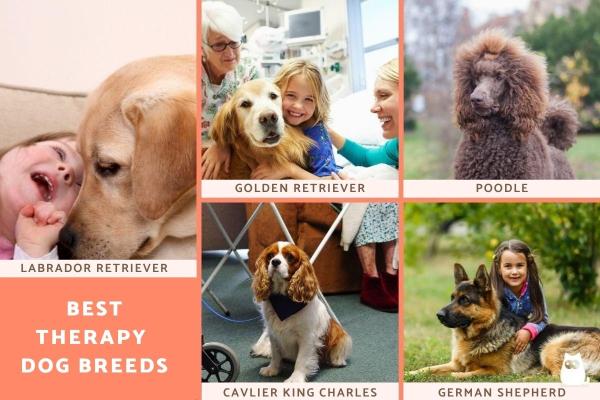
Animal-assisted therapy is becoming an increasingly beneficial tool for various clinical needs. Especially in psychology, it is common to find recreational, therapeutic and educational activities assisted by dogs. These can benefit the programming for schools, nursing homes, special education centers, prisons and hospitals. These benefits can really make the difference for individuals of all backgrounds and abilities, something we can see supported by various trials and studies.
As with other types of animal assistance, not all dogs will be ideal candidates to assist in therapy. At AnimalWised, we explain more about what being a therapy dog entails and provide our list of the best therapy dog breeds. While breed is only one factor, these breeds are generally calm dogs suitable for therapy.
What are therapy dogs?
A therapy dog is a canine that is used by healthcare professionals during therapeutic sessions. They provide support to service users of all kinds. When the therapy dog is used to support individuals with psychiatric problems, they are known as emotional support animals (ESAs). However, service dogs of various kinds can be used as emotional support animals.
All therapy dogs will be carefully selected, evaluated and educated to properly carry out their supportive roles. Such roles are structured and adapted to the needs of each service user. The relationships service users have with their therapy dogs tend to be long lasting, allowing strong bonds to be forged. This helps them in future sessions, especially during difficult periods and relapses.
The dog provides invaluable help by helpfully guiding the attention of the service user. Simply by being a friendly dog with whom they can interact, the service user's emotional, social and cognitive function can improve. Some animals are used in very specific ways, others are generally able to provide emotional support through their normal interactions.
Benefits of dog therapies
Since the beginning of the domestication of dogs, humans have established strong emotional bonds with canines. Although there have been and continue to be difficulties in caring for dogs, we cannot deny the improvement to well-being and quality of life dogs provide for millions of people on this earth.
Using dogs to provide emotional and practical benefit to humans is nothing new. In Ancient Greece, healing temples had dogs brought to them for patients to better recover. Since the end of the last century, but especially in the last few years, the body of scientific evidence supporting the use of therapy dogs has grown dramatically.
Thanks to many of these studies, we can look at the specifics of how dogs can improve recovery and symptom management. Benefits to patients and service users include:
- Improves social and communication skills, as well as encouraging initiative by joining group activities.
- Enhances self-esteem and self-confidence, provides a feeling of optimism.
- Increases the capacity for concentration and attention.
- Improves motor coordination in patients with movement difficulties.
- Reduces heart rate and blood pressure, facilitating a state of relaxation and reducing levels of stress and anxiety.
Although therapy dogs are used in clinical functions, many of us know the benefits to our well-being of keeping a dog as a companion animal.
Characteristics of good therapy dogs
All dogs have the capacity to benefit humans in some way, but there are certain characteristics which are needed for them to be a good therapy dog. For example, many dogs can be great companions around their caregivers, but will be shy around strangers. This means they might be a great dog for the family, but won't be ideal for therapy.
Some dogs are raised in specialized centers and may be designed for therapy from birth. From the time they are puppies, they are given appropriate stimulation and education so they can better benefit others. However, this isn't necessarily the case with all therapy dogs. Any dog which meets a certain level of criteria and has the right characteristics may be considered as a good therapy dog.
The main characteristics of good therapy dogs are as follows:
- Good socialization: it is essential that a good therapy dog has been correctly socialized since they were a puppy. They need to have had positive experiences with people, other animals, objects, sounds and environments. Good socialization allows the dog, to have self-confidence when they mature. It helps to avoid fears or phobias in the face of the unknown. We explain more with our article on how to socialize a puppy correctly.
- Habituation to handling: a therapy dog must be accustomed to all kinds of handling and it is important they enjoy company and human contact. During therapy, service users will most likely need to touch the dog. In some cases, they should be stroked, combed, or supported as part of therapy. Some individuals may not known how to behave around dogs, so a good therapy dog won't be scared of the unexpected.
- Interest in learning: therapy dogs must be trained using a respectful methodology based on positive reinforcement. The level of motivation of the dog and their engagement in activity needs to be high. Some dogs love to train and enjoy learning new tricks, but others are not as interested. Some may not want to interact on many occasions.
Last but not least, the therapist or trainer who is in charge of guiding the dog during therapy should have extensive knowledge of canine language and behavior. They will need to ensure that, in each session, the dog is comfortable and in perfect condition, both physically and mentally.

Best therapy dog breeds
There is no specific breed of therapy dog. As we have mentioned before, any dog can be trained for this job. What matters is their temperament and the education they receive.
However, it is true that some breeds show a genetic predisposition to becoming a therapy dog. This is because they present certain desirable character traits that can better facilitate the training process and their subsequent adaptation to therapeutic sessions. The most breeds mostly commonly associated as good therapy dog breeds include:
Labrador Retriever
Perhaps due to their historic use as seeing eye dogs, the Labrador Retriever is perhaps most associated with being a therapy dog or support animal. They have been used to carry out various types of assistance and aid work. Their cheerful and sociable nature makes them ideal company for both humans and other animals. Their great motivation to train and learn new skills is also an advantage. Labrador Retrievers are also ideally sized for all types of people, being robust enough to deal with handling without being easily hurt.
Golden Retriever
The Golden Retriever has a very similar origin, size and temperament to the Labrador Retriever, so much so the two breeds are often confused with each other. They are another of the star breeds when we talk about assisted interventions with dogs. They are a noble, patient, calm and very intelligent dog, ideal to participate in therapies with adults, children or the elderly. In addition, the Golden Retriever is said to have a special sensitivity to recognize human emotions and respond to them.
Poodle
Something that not everyone knows is that poodles are considered one of the most intelligent dog breeds. This is only one of the reasons they make such good therapy dogs. Their physical and behavioral characteristics have made them an ideal working dog. It is also very common to find crosses of a Poodle with a labrador (known as a Labradoodle) and with a Golden Retriever (Goldendoodle). As we can see, it is not only purebred dogs which make good therapy animals, but crosses can also use the best traits of more than one.
German Shepherd
Properly socialized and educated, German Shepherds are multi-purpose dogs that are fully engaged in whatever task they are trained for. They are very popular and beloved dogs, extremely intelligent and highly obedient.
Cavalier King Charles Spaniel
Perhaps less known as a therapy dog breed, this small dog of English origin is characterized by being very familiar and affectionate. Their sympathetic and playful nature have made them an ideal therapy dog breed for therapies with children, the elderly or with those patients who may feel a certain fear or insecurity towards larger dogs.
If you want to read similar articles to Best Therapy Dog Breeds, we recommend you visit our The most... category.